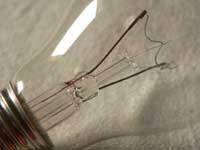A laser pulse sufficient to improve bulbs

When talking about incandescent bulbs, often highlights their low efficiency. And those who say this lack have no reason. In fact, incandescent bulbs only use 10% of the electricity they consume to emit light, the rest of the energy is transformed into heat.
It may seem that the bulbs waste a lot of energy, but it is not. Incandescent bulbs are essential for the emission of light at high temperatures, since the filament of wolframio (or tungsten, which has two names) that has the bulbs inside should be heated until its name indicates.
If the filaments were heated in normal environmental conditions until reaching such high temperatures, they would evaporate. They are introduced in glass ampoules to avoid it, making it empty inside or filling it with an inert gas. This ampoule is placed a metal case to perform the necessary electrical connections. And at the base it is already, those are incandescent light bulbs.

Compared to incandescent bulbs, energy-saving lamps use 80% less energy, mainly because they need much less heat to illuminate. (Photo: Jeramy).
A laser pulse to improve
Compared to incandescent bulbs, energy-saving lamps use 80% less energy, mainly because they need much less heat to illuminate. Researchers at Rochester University have not managed to reduce the consumption of a certain bulb, but to emit more light by consuming the same electricity.
They were not specifically sought. They were experimenting with ultra-fast laser pulses and it was seen that these laser beams were able to modify the structure of several metals, i.e., rearrange their atoms. Testing it with the filament of wolframio inside the bulbs, they saw that it emitted more light with the new organization.
As they have explained, the filament of wolframio was sent the laser pulses of a femtosecond lasting one billion a second. It is very important that the laser pulses are of short duration since they are able to melt the metal with its heat. If the duration of the pulses is very small, the metal molecules are only reordered, they do not fuse. Somehow they heat up and cool very quickly. After suffering the laser pulse, the researchers say that the wolframio becomes black.

With the new molecular arrangement, wolframio provides much more light without consuming more electricity. When blackened, it seems to increase the ability to receive and emit radiation.
The researchers, of course, have claimed that this experiment could have a great success in the market. It has also been commented that short-lasting lasers are very expensive, but their use on a large scale would represent a drastic reduction in the cost of treating each bulb.
The truth is that we do not know whether or not they are going to reach the market, it is very soon to make such predictions. However, it would be necessary to see if the bulbs recover the dissipated energy when dealing with these super-fast lasers, if they get the energy more efficiently...
Published in 7K.
Buletina
Bidali zure helbide elektronikoa eta jaso asteroko buletina zure sarrera-ontzian











